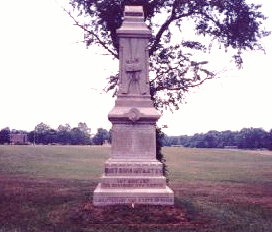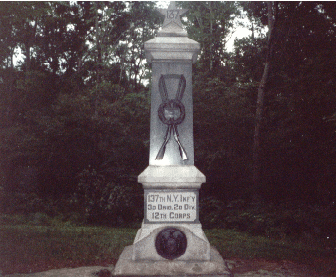Gettysburg
After the defeat at Chancellorsville the 61st Ohio and the Army of the Potomac recovered north of the Rappahannock River. The 61st encamped at Stafford Courthouse near Fredericksburg. On June 12 the 61st and the 11th Corps began marching north in pursuit of the Confederates, much to the relief of the men in the 61st who were in no hurry to face the rebels in "The Wilderness" again any time soon. The 61st crossed the Potomac River and entered Maryland on June 25, a day long remembered by the regiment. Despite the oppressive heat the men's spirits improved, not only because they realized that the next battle would be fought on northern soil but also because their rations improved due to Maryland's relative bountiful supply of food. On June 29, as rain brought relief from the heat, the 61st marched into Emmitsburg, Maryland. There the regiment encamped, just south of the Pennsylvania border.
After resting on June 30 the 11th Corps received orders on July 1 to march north towards Gettysburg, Pennsylvania, in support of the 1st Corps. However, before leaving Emmitsburg Lieutenant-Colonel William Bown and 103 men were ordered to Mechanicstown, Maryland. This left Colonel McGroarty with less than 150 soldiers to lead to Gettysburg. Struggling through the high humidity and muddy roads, McGroarty and his men could hear the sounds of battle growing louder as they neared Gettysburg. They reached Gettysburg around 1 p.m. and were positioned with their brigade, now led by Colonel George von Amsberg, northwest of town, in the fields between the Mummasburg and Carlisle Roads. Von Amsberg's brigade formed on the left end of the 11th Corps line, where it was to protect the right flank of the 1st Corps.
The 61st were deployed as skirmishers in advance of their brigade and were soon engaged in a sharp skirmish with a battalion of Alabama sharpshooters and with skirmishers from Brigadier General George Dole's Georgia Brigade. After about a half hour the Confederate skirmishers retreated but rebel artillery on Oak Hill prevented the Federals advancing. A stalemate followed with neither side able to gain an advantage and the fight turned into an artillery dual between the Confederate batteries and von Amsberg's artillery, the 13th New York Light Battery and Captain Dilger's Battery I, 1st Ohio Light Artillery.

61st Ohio Monument on Howard Ave.
The stalemate did not last long. At 3:30 p.m. Major General Jubal Early's Division struck the 1st Division on the 11th Corps' right flank, forcing the 1st Division to retreat and leaving the 3rd Division isolated. The 3rd Division soon pulled back into Gettysburg before they were cut off, leaving the 1st Corps in the same isolated position. The Union withdrawl began orderly but soon became a rout as the soldiers and artillery of the 11th and 1st Corps clogged the streets. A number of men from the 61st were captured when they became lost in Gettysburg on the way to Cemetery Hill. Those who escaped rallied on Cemetery Hill and the 61st spent the evening building breastworks near where the National Cemetery now stands.
Early on July 2 the detachment under Lieutenant-Colonel Bown joined the 61st on Cemetery Hill and the regiment spent the morning skirmishing with the Confederates. In the afternoon Captain James Reynolds and Company B were sent to support Captain Dilger's Battery, which was positioned near the Baltimore Pike. At about 4 p.m. the Confederate batteries on Benner's Hill to the west and on Seminary Ridge to the east opened fire on Cemetery Hill and the Union batteries soon returned fire. In the opening moments of this artillery battle a Confederate shell struck Captain Reynolds, wounding him in three places. He was carried to the 11th Corps hospital but the surgeons could not help him and the twenty-five year old native of Cincinnati died that night. Reynolds' company remained with Dilger's Battery under heavy fire for the next couple of hours until the artillery dual died down.
That evening the 61st and three other regiments from von Amsberg's brigade reinforced the Union right flank on Culp's Hill. Arriving on Culp's Hill at about 9 p.m. the 61st Ohio and the 157th New York were sent to the far right of the
Union line. There the 137th New York of Brigadier General George Greene's brigade was being forced back by the Confederate brigade of Brigadier General George H. Steuart. The 61st Ohio and the two New York regiments mounted a counterattack but were driven back. Reinforcements from the 1st Corps arrived to stabilize the Union line and heavy fighting continued in the darkness until about 10 p.m. when Steuart's attack died out.
The 61st remained on Culp's Hill through the night and returned to Cemetery Hill at daybreak on July 3. That afternoon the 61st came under

137th New York Monument on Culp's Hill, near where the 61st fought on July 2nd.
artillery fire during the cannonade which preceeded Pickett's Charge. While the artillery fire was not as intense for the 61st as the fire from the day before, it was still costly for the regiment. Dr. William Moore, the 32 year old Assistant Surgeon for the regiment, was struck by an artillery shell and died a couple of days later. The 61st remained in position on Cemetery Hill until July 5 when the Army of the Potomac began to pursue the retreating Confederates. During the Battle of Gettysburg the 61st had 6 men killed, 36 wounded, and 12 captured.



Three members of the 61st who are buried in the Gettysburg National Cemetery.